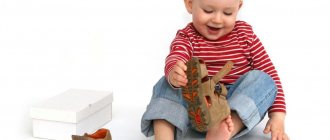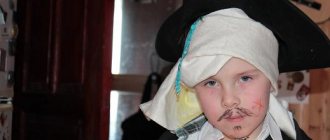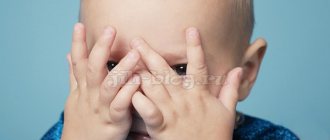Age-related features of sensorimotor development in children
Sensorimotor development is a special cognitive activity that has specific goals, means, objectives and methods of implementation. If preschool children are not provided with sufficient sensorimotor education, this will subsequently lead to difficulties in the process of primary education.
Sensorimotor function in childhood
Sensorimotorics implies the formation in a child of perception and ideas about the external properties of objects, and is the foundation of general mental development. Early and preschool age in children is considered the most favorable period for improving the functioning of the senses.
As practice shows, a child at each age stage turns out to be the most sensitive to certain influences. Early childhood is recognized as the golden age of sensorimotor development, since during this period familiarization with the properties of objects occurs.
Note! At an early stage of upbringing, a child develops a broad orientation in the subject environment. He not only gets acquainted with the shapes, colors and sizes of objects, but also improves the sound analysis of speech, forms an ear for music and develops muscle senses.
As soon as a child begins to walk independently, he gains relative independence and strives to explore everything around him with the help of his hands. It is during this period that a new stage in the development of the brain and motor skills begins, during which familiarization with the surrounding objective world occurs.
Note! In the period from 3 to 7 years, children exhibit a characteristic relationship between the development of sensory and motor skills. This is explained by the fact that during this period the corresponding areas of the preschooler’s brain mature, which are responsible for performing important mental functions.
By the end of the early childhood period, if all the necessary conditions have been created for the child, in the older group of preschool educational institutions, the development of sensorimotor occurs at an accelerated pace.
Since during sensorimotor development, young children need to be involved in activities and form actions and perceptions, sensorimotor development must necessarily be carried out under his close supervision.
Systematic work on sensorimotor perception of children contributes to the formation of skills that confirm a high level of perception. Experts recommend working with children within the framework of a playful, didactic game. From this approach, children enjoy and get acquainted with new norms and rules.
Features of sensorimotor
The range of tasks that sensorimotor education solves
The preschool period is an important stage in the formation of skills and the assimilation of a child’s knowledge, both in terms of psychology and other characteristics. Many abstracts and articles have been written about this. In the process, the training technique is based on sensorimotor development.
Mathematical classes in preparatory groups according to the Federal State Educational Standard
Range of tasks of sensorimotor education:
- Development of fine motor skills in preschool children.
- Development of gross motor skills.
- Formation of a system of examination actions in children.
- Formation of a system of sensory standards.
- Improving and developing the skills to independently apply the system of perceptual actions.
- Development of auditory and visual perception.
Note! Based on the goals and objectives listed above, parents and teachers of preschool educational institutions should try to create for children all the necessary conditions for sensorimotor development.
We develop sensorimotor skills with a child from 2 to 3 years old
With sufficient attention from adults under 2 years of age, children of this age already have a good experience of sensorimotor skills and easily respond to the invitation to explore new options. There is a desire to create, to create fictitious images. Coordination and motor skills allow you to introduce new options for stimulating sensory-motor functions into your baby’s life. Thanks to the development of primary speech skills, based on the experience gained, increased curiosity appears. It is this skill that will become the main driver in learning new knowledge.
How to develop sensorimotor skills
The child’s readiness for school almost entirely depends on the degree of sensorimotor skills. By the end of the preschool period, normally developing children should have a fully established system of perceptual actions and sensory standards.
Insufficient sensorimotor development leads to a variety of difficulties during initial learning. To prevent this from happening, it is important to start exercises and activities as early as possible, preferably immediately after the birth of the baby.
Development of gross motor skills in preschool children
Not everyone has an idea about gross motor skills in children, what they are, and the movements of large muscles of the body. Its formation begins much earlier than the small one. There are many different exercises and games to develop gross motor skills.
Note! The simplest way to develop gross motor skills is to perform all kinds of exercises while exercising. Various turns, bends, squats, jumps and much more help the child learn to control his body.
You can learn attentiveness and coordination of movements through games with a skipping rope, as well as in the process of throwing and hitting the target with balls. You can strengthen your muscles by dancing, cycling, scootering, rollerblading and skating.
Gross motor skills
Development of fine motor skills
Fine motor skills in preschool children refers to the movement of small muscles in the hands. Fine motor skills contribute to the development of speech, interact with imagination, thinking, observation, attention, coordination, as well as motor and visual memory.
It is recommended to begin developing fine motor skills from the age of eight months. This is explained by the fact that during this period the baby’s fingers are already amenable to active training. You can begin to develop motor function earlier, but still, the age of 8 months, according to experts, is the most optimal.
Drawings on the topic of traffic rules in kindergartens - safety through the eyes of children
Note! The choice of tools for developing children's fine motor skills is varied. Moreover, the more methods are used, the greater the results can be achieved.
Playing with cereals, buttons, pebbles and beads has an excellent developmental, tonic and health-improving effect. These games include exercises using tongs, drawing from cereals and exercises using tweezers. You also need to systematically give your child a regular coloring book in which he can show his imagination. In this case, the child should play and perform relevant tasks only under the close supervision of an adult.
Finger games, which are a kind of dramatization of stories, also contribute to the development of fine motor skills. You can start classes with your child from an early age, before the age of one, and systematically complicate the program over time. During such games, not only the hands, but also the fingers are fully involved.
Modeling from plasticine, clay or salt dough perfectly develops fine motor skills. In addition, experts with extensive experience working with children claim that such activities excellently develop children's imagination.
Important! Exercises using additional objects are considered exciting and entertaining.
Fine motor skills
Exercises and games for a child from birth to 1 year
The first year of a child's life is one of the most eventful. Skills appear literally before our eyes, so it is important not to miss the opportunity to develop sensorimotor skills with the help of exercises in the first half of life and supplement them with the first games after mastering the skill of holding the body in a sitting position.
Recommended exercises for children under 6 months
- Look at the toy
- When to start: from the first week of life.
- Items needed: brightly colored rattles.
- Frequency: 2 times a day.
- Time: 1-2 minutes.
An adult places the toy at a distance of 70 cm from the child’s eyes. When the baby concentrates his attention on the object, you need to slowly move the rattle left and right by 5-7 cm. After mastering the skill of moving your gaze behind the object, you need to complicate the exercise by moving the proposed object in different directions, closer and further from the baby.
- Listen and grab
- When to start: 2 months.
- Necessary items: rattle-garland for the crib.
- Frequency: 2 times a day.
- Time: 5-8 minutes.
A garland is attached to the crib at arm's length for the baby. Draw your little one's attention to the toy with a slight noise. Having become interested in the proposed toy, the baby will try to reach out and touch the proposed object, strengthening the connection between the sound of the toy and its appearance. To enhance the effect, it is necessary to periodically (at least once a week) replace the garland.
- Studying mom's face
- When to start: 2 months.
- Frequency: 2-5 times a day.
- Time: 1-2 minutes.
Take the baby in your arms under the arms in front of you. Try to attract his attention to you with a song or sounds. Try to keep his attention on your face.
- Getting to know the toys
- When to start: 3 months.
- Necessary items: toys of different shapes, colors, textures.
- Frequency: 2 times a day.
- Time: until loss of interest.
A variety of objects differing in color, shape, sound, and surface are placed in the baby’s hand. After your baby explores objects while lying on his back, place him on his tummy and place the toys in front of him. Leaning on his elbows, the baby will try to reach them, try them by touch and taste.
- Massage
- When to start: from birth.
- Frequency: 1-2 times a day.
- Time: 5-7 min.
The main way to develop psychomotor skills in the first year of life is a relaxing massage, which allows the child to feel his body and explore its possibilities. It is imperative to carry out this procedure with warm hands lubricated with baby cream. Special attention should be paid to the baby’s palms and feet: they contain points for stimulating the development of individual organs and the brain.
- Listen
- When to start: 1 month.
To activate sensorimotor skills, a prerequisite is the use from the first days of life of speech addressed directly to the child in a wide variety of forms. Songs, stories, jokes, simple sounds. Closer to 6 months, you can use various pictures, voicing the animals and objects depicted in them. During games, name objects, avoid diminutives and substitutions for simple forms.
Options for sensorimotor games from 6 months to a year
- Finger fun
“Magpie-crow”, “horned goat” and other finger games that require warming up the palm and are accompanied by rhyming stories.
- Finger painting
By moving your fingers dipped in paint along a sheet of paper, help your baby explore different colors and feel the different structures of materials.
- Modeling
It’s good to start basic dough modeling as early as possible; you can additionally paint or decorate the resulting sausages and circles. It is advisable to introduce plasticine no earlier than 11 months: it has a denser structure and is difficult to transform.
- Sensory cubes, mats, soft bodyboards
Filled with different cereals, with sewn objects of different sizes, making sounds and in addition massaging the baby's body, the items are ideal for children from 6 months to develop sensory-motor skills.
- Construction
By 7-8 months, cubes are offered for building simple towers. It would be good if, along with the classic hard ones, their soft counterparts and sensory bags were included in the game. By 11-12 months, you can offer a construction set with large parts.
- Introduction to classical music
Music allows children to experience new sensations, gain new experience of exploring the world, and stimulates the functioning of brain neurons. Listening to classical music and trying to express inner emotions through movement (dance) has a general positive effect on sensorimotor.








